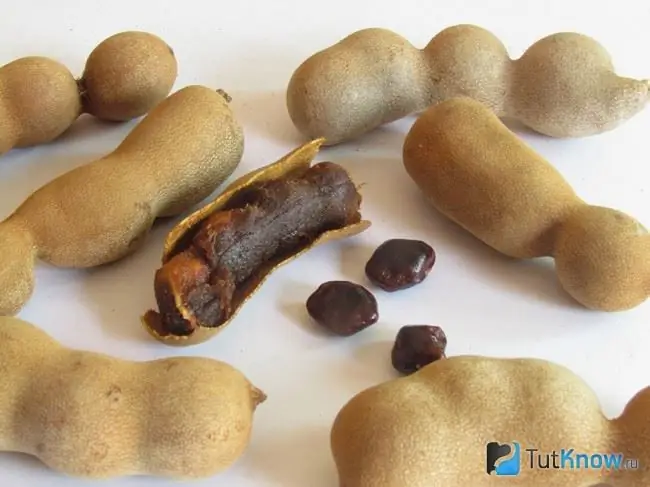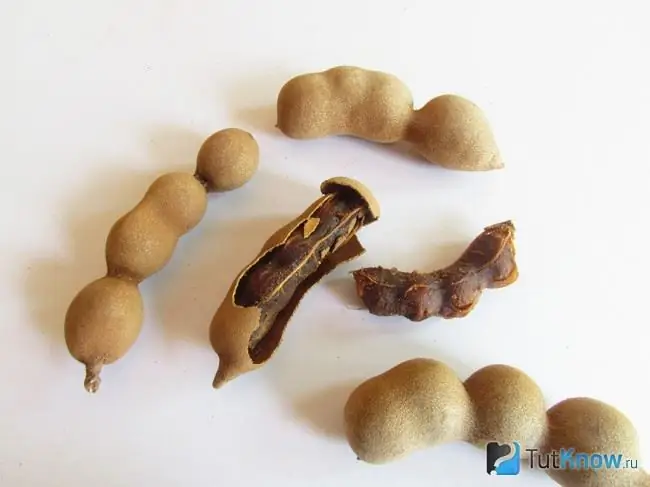- Author Arianna Cook [email protected].
- Public 2024-01-12 17:55.
- Last modified 2025-01-23 09:40.
Useful and harmful properties of a sweet "pod fruit" called tamarind. Its composition is vitamins, trace elements and calories. Tamarind is an exotic fruit of the legume family. In addition to the botanical name - Tamarindus indica, there is another, more common - Indian date. Outwardly, it resembles the same bean, only brown. Fruits appear and ripen on the tropical Tamarind tree, the only one of its kind. Cultivated in all tropical countries. In cooking and preparation of medicines, the fruits of the plant are used - beans, what surrounds the seeds inside the pod - pulp, tree bark, leaves. They all contain many useful substances.
The tree itself is very tall and reaches 20 meters. Outwardly, it looks like our acacia: it has the same huge number of regular pair-pinnate thin leaves and brown pods, but evergreen.
The chemical composition of tamarind: calories and vitamins

Traditional medicine in hot countries knows recipes from tamarind seeds, its pulp, bark, leaves and even flowers. In cooking, the pulp of beans is used: for the preparation of sauces, the pulp of an unripe fruit is taken, because it is sour, and for the preparation of mousses and drinks, it is ripe, because it is tasty and very sweet. You can eat the fruit fresh, frozen, dried, candied. Tamarind will not lose its nutritional value: in a large amount of carbohydrates, 3 g of protein and dietary fiber, vitamin C, B vitamins (thiamine, niacin, riboflavin), rich in phosphorus, iron and magnesium.
Calorie content of tamarind - 239 kcal
per 100 g of pulp, also in Indian dates per 100 g:
- Proteins - 2, 82 g
- Fat - 0.59 g
- Carbohydrates - 62.7 g
- Fiber and dietary fiber - 5.09 g
- Sugar - 57.5 g
- Ash - 2, 7 g
- Water - 31.5 g
Macronutrients and trace elements:
- Potassium - 627.9 mg
- Phosphorus - 113.2 mg
- Magnesium - 92, 0 mg
- Sodium - 28.5 mg
- Calcium - 73.8 mg
- Iron - 2.80 mg
- Zinc - 0.1 mg
- Copper - 0.08 mg
- Selenium - 1.4 mcg
Vitamins in tamarind:
- Provitamin vitamin A (beta-carotene) - 18 mcg
- B1 (thiamine) - 0.43 mg
- B2 - 0.15 mg
- B3 - 2 mg
- B4 (choline) - 8.5 mg
- B5 - 0.14 mg
- B6 - 0.07 mg
- Ascorbic acid (C) - 3, 52 mg
- E - 0, 11 mg
- K - 2.79 mcg
As you can see, the Indian date has a lot of useful things for the human body. For example, thiamine contained in tamarind is necessary for the human body for the proper (healthy) functioning of the digestive system, nervous system, and musculoskeletal system. Potassium helps the heart and smooth muscles. Iron - supplies the organs with oxygen.
Useful properties of tamarind

1. Slimming
Both Indian date seeds and preparations based on it help our body to become slimmer. They contain hydroxycitric acid, which blocks the action of enzymes that accumulate nutrients "in reserve". She also burns fat.
Tamarind reduces appetite and it also promotes weight loss. As soon as the substances of the fruit enter the bloodstream, the level of serotonin rises and the feeling of hunger is dulled.
The Americans established the production of a dietary supplement containing hydroxycitric acid from tamarind.
The fruit is good for diabetics, it lowers sugar levels.
2. To lower cholesterol levels
Tamarind contains many antioxidants (ascorbic acid and plant phenols). This is not only to maintain youth, but also stops the deposition of cholesterol plaques on the walls of blood vessels. Scientists even made one discovery: the maximum amount of phenols in Indian dates appears at the moment of boiling point. In other words, the fruit is good to cook.
Lowering cholesterol has a positive effect on lowering blood pressure.
3. Tamarind to improve digestion
For a long time, tamarind has been used in food in tropical countries to relieve diarrhea and constipation. It not only improves digestion, but also normalizes appetite, reduces gas formation, and treats abdominal pain.
Eating tamarind can smooth out or completely neutralize the effects of food poisoning, eliminate vomiting and nausea. It is also possible to prevent the onset and development of stomach ulcers.
4. For women's health
A rare fruit has properties useful for the female body, tamarind is one of them. Eating it in food, hormones return to normal. Not only in the tropics, but also in most countries of the world, the Indian date is used to treat "female" diseases, heal the body as a whole, and restore sexual desire.
In general, tamarind is useful for feverish conditions, after sunstroke, helps to recover from paralysis. By preparing an infusion from the leaves, you can cure not only inflammation, but also irritation on the skin.
In cosmetology, the beneficial properties of tamarind are no less in demand. In spas, tamarind water is added to wrap creams. On the basis of the pulp of the fruit, masks are made for oily and problem skin. The oil is also used in cosmetics, because rich in amino acids.
Video about the benefits of tamarind:
Tamarind harm

For spice lovers, it makes sense to refrain from heavy consumption of spices containing tamarind. Firstly, it is fraught with diarrhea, and secondly, you can get diseases of the digestive glands.
It is not recommended to eat an unripe Indian date and sauces from it for patients with hyperacid gastritis, peptic ulcer disease, a disease of the digestive glands. The consumption of this fruit is contraindicated in pregnant women and nursing mothers.
How tamarind is chosen
A good fruit has a smooth and firm rind, brown, rich and vibrant. There should be no external damage.
Interesting Facts
Tamarind seeds contain "amber" oil. Artists use this natural dye in varnishes and cover paintings and wood sculptures with it.
Ancient beliefs say that the Indian date brings good luck. But only in the place where it grows. And if you carry seeds with you, you can protect yourself from cut wounds and bullets.
According to the observations of local botanists, grass does not grow under the tamarind tree.
Video - fruits of Thailand:



